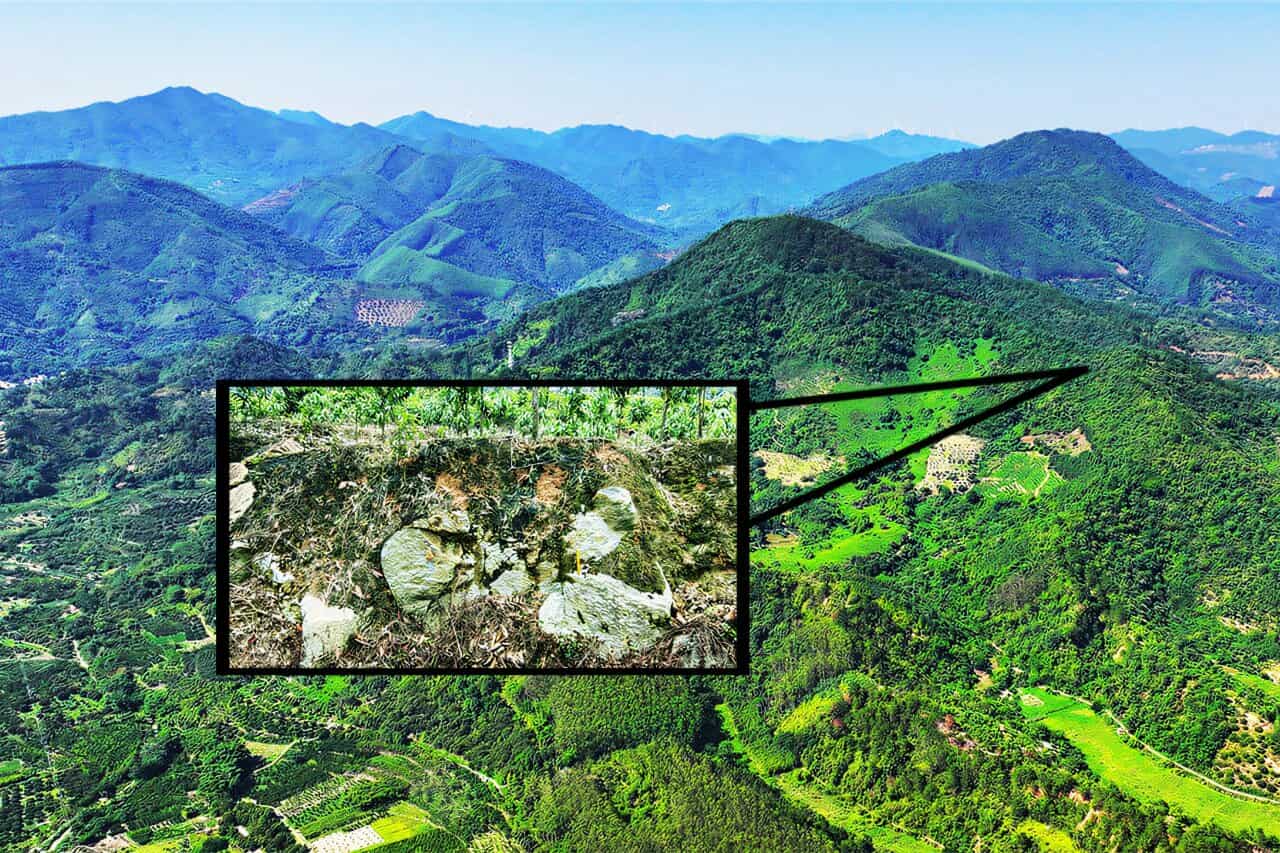 A panoramic aerial drone image of the Jinlin crater with the approximate location of the crater rim labeled, with an insert of the crater floor, which shows a mix of granite weathered soil and granite fragments. The yellow ruler is 20 centimeters long. Credit: Ming Chen.
A panoramic aerial drone image of the Jinlin crater with the approximate location of the crater rim labeled, with an insert of the crater floor, which shows a mix of granite weathered soil and granite fragments. The yellow ruler is 20 centimeters long. Credit: Ming Chen.
We’ve identified only around 200 meteorite craters worldwide, and there’s a very good reason for that: they’re hard to find. Craters get eroded and covered by vegetation and soil, and this new crater is no exception. The latest crater was confirmed on a lush, green, rain-soaked hillside in southern China. It’s a vibrantly alive place, covered with thick soil, dense vegetation, and relentless monsoons. It is, by all accounts, the last place you’d expect to find a pristine scar from space.
Yet, they proved that the crater (called Jinlin crater) is there.
This is the first impact crater ever found in southern China. With a diameter of 900 meters, it’s also the biggest “modern” crater ever discovered on Earth. It also shows that our planet is hiding far more of its violent past than we ever realized.
Armageddon Where?
Forget the dusty, pockmarked moon or the red plains of Mars. The Earth has also been hit a lot. Our atmosphere burns up a lot of meteorites and asteroids, but some of them do get through.
Our planet is not a museum like the Moon. Earth’s archive is dynamic and self-destructing. Because we have active plate tectonics, the surface of our planet is constantly pushed into the mantle and recycled, with new one being formed as well. Volcanoes can erupt, paving over the evidence. And perhaps most important, wind, water, and life grind mountains down and cover them.
China is a great example of this. Its surface is nearly 10 million square kilometers. China alone is 25% of the entire surface area of the moon. Statistically, it should be littered with craters. But until now, only four craters had been discovered, and all of them were in the dry, north-eastern part of the country. In Southern China, nothing.
The assumption was that the region’s hot, subtropical climate was simply too good at destroying the evidence. Even large impacts could be easily covered by vegetation in millions of years.
In fact, the Jinlin crater doesn’t exactly look like a crater. It’s tilted, with a bunch of weathered soil and large chunks on its rim. The floor is also a jumbled geological mess. It does look like a crater, but how do you actually prove it?
To show that it is indeed a crater, the researchers didn’t go big. They went small.
Seeking a Crater
The team collected rock fragments from the crater floor. They sliced them into thin sections and put them under a powerful petrographic microscope. In particular, they were looking at tiny quartz grains for a smoking gun. That smoking gun is called Planar Deformation Features (PDFs).
To get the official “impact” stamp, you need proof of shock metamorphism. This is a fancy term for what happens when a rock is hit so hard, so fast, that the pressure fundamentally changes its atomic structure. This process leaves distinguishing marks. These traces only form under shock pressures between 5 and 30 gigapascals (GPa) — an instantaneous blast of pressure hundreds of thousands of times greater than at the bottom of our deepest ocean.
On Earth, the formation of planar deformation features in quartz is only from the intense shockwaves generated by celestial body impacts, and its formation pressure ranges from 10 to 35 gigapascals, which is a shock effect that cannot be produced by any geological process of Earth itself,” said author Ming Chen.
In this case, the impactor was most likely a meteorite. Based on the crater’s size, the team estimates the object that struck was about 30 meters wide. The researchers haven’t figured out whether the meteorite was made of iron or stone.
However, the team did date the impact.
Recent Impacts
They looked at the granite fragments (less than 30 cm) sitting on the crater floor. At that known weathering rate, a 30 cm chunk of granite should be completely transformed into residual soil in less than 10,000 years. But the fragments they found aren’t dissolved. They are described as “fresh” or showing only “incomplete soil transformation”. This means the impact must have happened recently.
Of course, “recently” in geological terms. The team concludes it “most likely occurred during the early to middle Holocene”. The Holocene is the geologic epoch that started about 11,700 years ago. It is, for all intents and purposes, the entire history of human civilization.
“This discovery shows that the scale of impacts of small extraterrestrial objects on Earth in the Holocene is far greater than previously recorded,” said Chen.
For decades, we’ve looked for craters in the easy spots: deserts and ancient, frozen plains. The Jinlin crater shows that a different approach is possible. How many other “bowl-shaped depressions,” hidden by jungle and soil, are just waiting to be discovered?
The study was published in the journal Matter and Radiation at Extremes.


